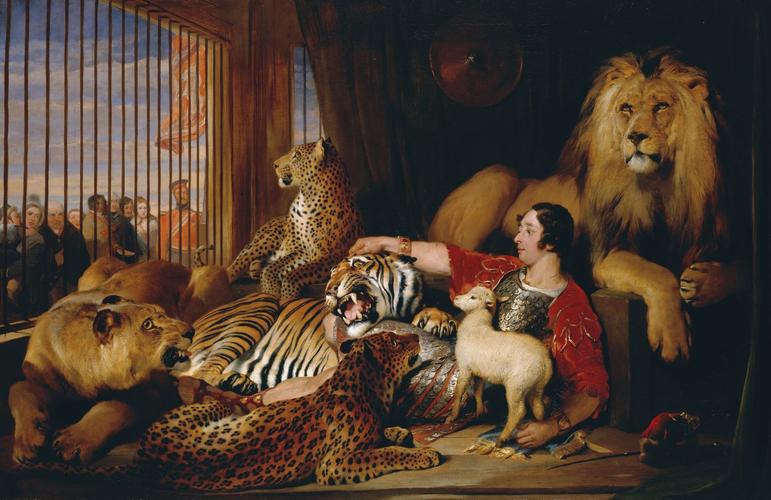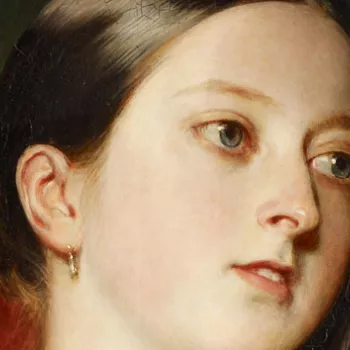Isaac van Amburgh and his Animals Inscribed 1839
Oil on canvas | 113.7 x 174.8 cm (support, canvas/panel/stretcher external) | RCIN 406346
-
Isaac van Amburgh, an American lion tamer of Dutch extraction, took London by storm in 1838-9 with his daring performances at venues such as the Drury Lane Theatre and Astley's Amphitheatre. Queen Victoria was a great admirer of the show, remarking that 'you can never see it too often, for it is different each time.' (Journal, 29 January, 1839). Indeed she attended seven times over a period of six weeks, and on one occasion stayed behind to watch the animals being fed.
Landseer has placed the viewer with Van Amburgh inside the cage while a heterogenous crowd peers in through the bars, an unusual compositional feature which particularly struck Queen Victoria upon first seeing the painting in production. Van Amburgh's act was set in ancient times, he wore Roman costume and was known as the 'Brute Tamer of Pompeii'. This scene forms the finale of the performance in which he enacted the biblical text 'The wolf shall live with the lamb, the leopard shall lie down with the kid' (Isaiah 11:6). However, the snarling tiger, predatory leopard and flinching lamb suggest the scene of harmony is artificial and potentially short-lived; during one performance one of the leopards seized the lamb, to the shock of the audience, although it survived unhurt (Rowell 1978, p.25). At the time this picture was painted, the keeping of animals for display was not unusual, without the animal welfare concerns that are prevalent today.
This was one of Queen Victoria's first commissions to Edwin Landseer, although she had expressed admiration for his paintings at the Royal Academy as early as 1833 (Journal, 3 May) and he had painted her spaniel, Dash, in 1836 at the request of her mother, the Duchess of Kent. Landseer would go on to produce over forty works for the Royal couple, many of which exemplify his much-admired skill in depicting animal fur and anatomy. The lion presiding over the picture bears a striking resemblance to the four that were cast in bronze from Landseer's model for the base of Nelson's column in Trafalgar Square, unveiled in January 1867 after ten years' work.
Queen Victoria was evidently very happy with her picture. On 23 February 1839 she 'went into the Drawing Room to see a most beautiful picture by Landseer of Van Amburgh, with his lions, tigers &c., reclining in the den in the midst of them, just as exactly as I saw him. It is a wonderful piece of painting' (Journal). She was less happy with the artist's business practice, and continually frustrated by his unreliability and delays in sending invoices. It was probably largely thanks to the diplomacy of the Queen's Dresser, Marianne Skerrett, who was responsible for conveying commands from her mistress to the artist, that the relationship between Landseer and his royal patron was as long and fruitful as it turned out to be.
Text adapted from Victoria and Albert: Art & Love, London, 2010Provenance
Commissioned by Queen Victoria (payment to Landseer dated 11 September 1840, £315, QV Ledgers 1840/6)
-
Creator(s)
-
Medium and techniques
Oil on canvas
Measurements
113.7 x 174.8 cm (support, canvas/panel/stretcher external)
153.0 x 215.8 x 17.0 cm (frame, external)
Category
Object type(s)









